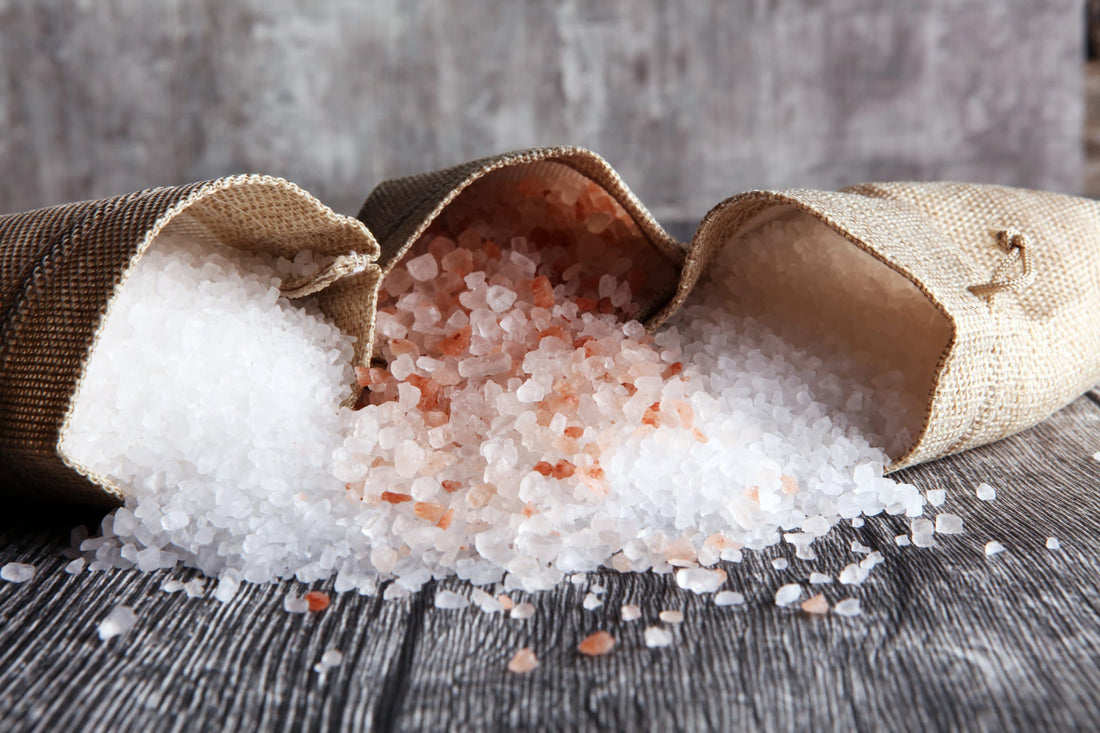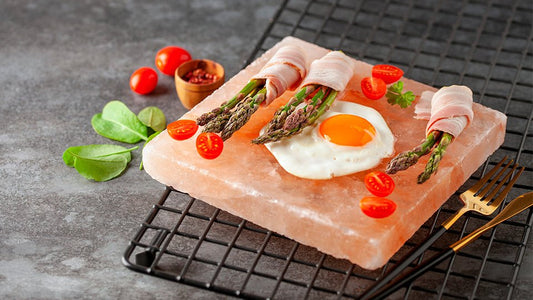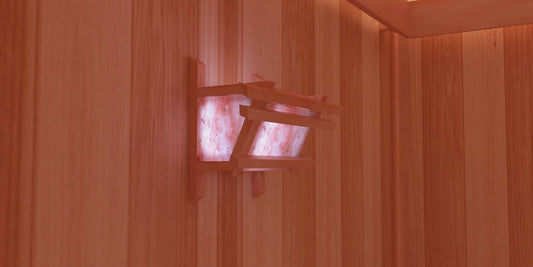Scientists believe the Himalayan salt to have been formed 300 million years ago from the evaporation of ancient bodies of water.
These happenings are near the Himalayan Mountains stand today, Khewra Salt Mines in Pakistan. Over time this salt has retained its natural purity, thanks to the mountainous region which sealed them from chemicals and pollutants.
That is why Himalayan pink salt is now considered one of the healthiest natural salts known to man.
Part of the innate beauty of Himalayan Salt comes from the fact that it's 100 percent pure and naturally occurring. That means that no two salt crystals will ever look the same. Veining throughout the Salt from varying levels of minerals gives way to unique different types of patterns and colors, ranging from pale white, pink, orange, and red.
So what's the difference in the colors?
The deepness of the salt's color largely depends on the amount of iron oxide running through it.
White Himalayan Salt is the rarest of the Himalayan Salt colors because it's the freest from impurities. At the same time, added minerals give pink Himalayan Salt its pink color, or red Himalayan Salt its reddish color. The color doesn't matter much from a health standpoint; they all pack 84 naturally occurring minerals.
White Himalayan Salt is Not as Common
Usually, white Himalayan Salt is found in the outer areas of a salt mine. It is low in iron which is why it is white. This type of Himalayan Salt isn't as common as the pink Himalayan Salt but just as effective. Of course, its rarity comes at a cost, so you will notice that the white variant is more expensive when buying Himalayan Salt products.
Do White Himalayan Salt has more health benefits?
The short answer is no; the health benefits Himalayan Salt provides are the same as pink and white. The only difference is that white Himalayan Salt is more difficult to find; hence it is more expensive.
How to check the authenticity
At first glance, it is pretty difficult to distinguish genuine from fake Himalayan Salt.
Nevertheless, there are ways to prove the authenticity of the Himalayan Salt. Let's go over some essential things you need to know to spot a fake Himalayan salt.
The Color of the Salt
Genuine Himalayan Salt has a light pink, orange or reddish color because it contains iron and other minerals. On the other hand, fake Himalayan salt is much paler.
This test is nearly impossible to use for white Himalayan salt, so the following methods have to be used.
The Shape and Size
Compared with fake Himalayan Salt, there is usually a difference in size. Himalayan Salt has the shape of slightly larger crystals.
But it would help if you were careful because original refined Himalayan salt products are sold on the market.
The Taste
The taste of real Himalayan salt is slightly saltier than that of fake Himalayan Salt. Genuine Himalayan Salt does not leave a bitter taste as it is free from additives.
Other ways
Himalayan Salt melts more quickly when you place it on the ground or in a humid environment.
Natural Himalayan salt is also slightly sticky and rough when you touch it. Even when it dissolves in water, Himalayan Salt remains fine-grained.
Himalayan Salt vs. Table Salt
Extraction
Table salt is produced by mechanical evaporation of brine. The crystallization process from brine leads to a highly purified table salt crystal with fewer impurities — hence its white color than the Himalayan salt hues.
Himalayan Salt is hand-mined from rock salt deposits exclusively in the Khewra Salt Mines located in the Punjab region of Pakistan. It is also minimally processed to yield a crude product free of additives.
The Mineral Breakdown
According to the National Center for Biotechnology Information, table salt is around 99.8% sodium chloride, and pink salt is on average 96.2% sodium chloride.
One the remaining 3.8% of the pink salt is where we find all the additional health benefits. Himalayan Pink Salt contains x7 more calcium, x16 more potassium, x33 more magnesium, and x470 more molybdenum than regular table salt. All of which are essential for basic life functions.
Himalayan salts have varying shades of color, including white, pink and dark red. These same minerals, especially iron, give them these characteristic colors.
Himalayan salt provides more essential elements and contains fewer harmful ones. Regular table salt contains traces of cadmium, lead, and mercury, all defined by Food Standards Australia and New Zealand as a metal contaminant schedule 19, the maximum level of contaminants and natural toxicants.
Different colors mean different things.
It is no secret that Himalayan Salt has become hot among health enthusiasts nowadays. It's a much-talked-about subject, even debated about as well! From the different colors of Himalayan Salt to the claims of its remarkable healing powers, it seems like this salt is attracting more and more attention each day. Loyal users of Himalayan Salt have given up the use of regular table salt in favor of a more pure, holistic option. Do you ask why?
One thing that may be intriguing for many is the different colors of Himalayan Salt. Although it mainly exists in varying hues of pink or orange, its color is not homogeneous. The color of Himalayan Salt is one of the main distinctive features of this salt.
White Himalayan salt
Crystals of Himalayan Salt may be white when extracted from outer areas of the Himalayan pink salt mine. Since these are a rare variation of the natural rock salt, you can expect the price to be slightly higher than the usual Himalayan Pink Salt.
White Himalayan Salt can vary in shades from pale pink (almost like rose quartz) to grayish hues to pure white.
White-colored Himalayan salt is usually used to make salt lamps. The color doesn't create any difference in the effectiveness of salt lamps.
Himalayan salt lamps made from white Himalayan salt crystals are also said to generate negative ions to clean the air. Negative ions generated from white salt lamps may potentially clear the air from dust, dander, and harmful positive ions present in the form of electronic smog. They alleviate allergies, respiratory problems, headaches, migraine, and even many skin conditions.
White is utilized for metaphysics' purity, love, clarity, and peace. No way to underestimate this one, right?
Pink Himalayan salt
Pink Himalayan salt is the most common form of Himalayan salt available in nature. The pink-orange hues of the salt make it a favorite for forming affordable Himalayan Salt lamps that reflect the shade of these crystals to create a calming aura. These lamps clear the air, promote peaceful sleep, and heal ailments.
Himalayan Pink rock salt is becoming a household favorite for the variety of purposes it can be used for. If you think salt is to sprinkle over your savory dishes, think again!
From luxurious baths infused with essential oils and packs of bath salt to their uses in daily beauty and skincare regimens, it seems like this is a must-have ingredient in your pantry!
Cook meat over pink Himalayan salt blocks to soak up the goodness of minerals in your steaks along with the flavor. Drink a small portion of diluted Himalayan salt solution (sole) early morning for an energy boost. Rub over skin to smoothen out rough patches, eczema, or cellulite. The list goes on with new uses being discovered each day!
Brownish-red Himalayan salt
Himalayan Salt is said to get its unusual reddish-brown hues from its minerals and elements in trace amounts. The essential constituent elements of salt are sodium and chloride, and anything other than that is the trace elements.
Red color mostly comes from the high iron content in Himalayan Salt. Other than that, the number of essential Himalayan salt minerals is far from limited, including calcium, magnesium, zinc, and naturally occurring iodine, among other numerous elements.
Red Himalayan Salt is an iron-rich variety of salt. Some salt crystals of generally the same color may vary since the iron content among Himalayan salt crystals isn't constant.
These red or light red-colored Himalayan salt crystals are mainly used as finishing salt in margaritas to enhance the presentation.
So, Which Should You Add to Your Food?
Knowing you have a lot of choices can be pretty comforting at times, while the exact thing can make you uneasy when you can't seem to decide! With the various hues of Himalayan salt available, choosing the best out of those might not be obvious.
It is a common myth that the darker the salt, the higher its mineral content. This myth is false. Dark colors correspond to higher iron content since iron imparts a reddish-brown color to foodstuff. The component giving your red blood cells their primary red color is Haem, also made of iron!
Try It Out!
It's curious how some people claim that this salt tastes different from regular table salt. Chemically, they are both sodium chloride. Over time, physical incorporation of other elements in Himalayan salt minerals could have changed the taste, maybe?
In this era of excessive machining and synthetic products, finding something genuinely natural can seem next to impossible. It's a comforting thing to know you're at least trying to make healthier choices. You should try using it once and decide based on your cooking experience.
Whatever the color of Himalayan Salt, one thing is for sure - its natural, unadulterated state is beyond comparison to your regular white table salt.
Now you know everything you need to be a Himalayan salt expert!





2 comments
How can I tell if a pink Himalayan lamp is a pure Himalayan salt rock?
Thanks for sharing this amazing article.